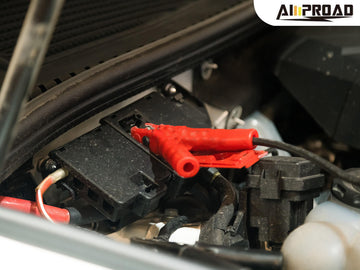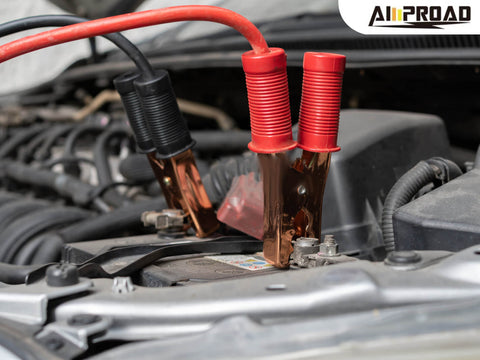
Jumped your car but it still won't start? Don't worry, this isn't always a dead battery! We'll troubleshoot common jumpstarting mistakes to make sure you connect everything right. We'll also explore other reasons your car might be cranking but refusing to turn over, helping you get back on the road in no time
Is it a Jump Start Issue?

Jumped your car and still nothing? Before you resign yourself to a tow truck, let's diagnose the problem. The key lies in how your car reacted when you tried to start it initially.
Did the car crank at all when you tried to start it?
If yes, could be spark plugs, ignition system, or fuel delivery issue (move to the last section).
If your car cranked and produced a whirring sound, indicating that your battery has sufficient power to turn the engine, but still won't start, there may be other underlying issues to consider. One potential cause could be faulty spark plugs, which can prevent proper ignition. Another possibility is problems with the ignition system, such as a malfunctioning ignition coil or distributor. Additionally, issues related to fuel delivery, such as a clogged fuel filter or a faulty fuel pump, could also be to blame. These potential causes will be further explored and addressed in the final section of this guide.
If no, jump start might be the solution (continue to the next section)
If your car didn't crank and there was no sound, it's a classic indication of a dead battery. In such a situation, a jump start could be the solution to get you back on the road. However, before attempting a jump start, it's essential to troubleshoot potential mistakes and ensure that you're performing the procedure correctly. Head over to the next section to learn about common jump start errors and how to avoid them.
It's important to remember that even if a jump start successfully gets your car going this time, it's still wise to have your battery checked by a mechanic. Regular battery maintenance and inspections can help prevent future breakdowns and ensure that your vehicle remains reliable. By addressing any underlying issues with the battery promptly, you can avoid being stranded in the future and prolong the life of your vehicle's electrical system. Don't wait until you're stuck on the side of the road again—schedule a battery checkup with a qualified mechanic today.
Jump Start Troubleshooting
When your vehicle's battery is dead and you're in need of a jump start, it's crucial to troubleshoot any potential issues to ensure a successful outcome. Begin by assessing the condition of the battery and verifying the connections. If the battery is indeed dead, proceed with the jump start procedure carefully, following the correct sequence of steps. Additionally, consider factors such as the age of the battery and the condition of the jumper cables. By addressing these elements methodically, you can increase the likelihood of a successful jump start and get back on the road with confidence.
Was the jump start procedure followed correctly?
When your vehicle's battery is dead and you need to jump start it, following the correct procedure is crucial to ensure a successful outcome. Understanding how to boost a car properly can make all the difference. Follow these simple steps to ensure a successful jump start:
- Connection Order: One of the most important aspects of jump starting a car is connecting the jumper cables in the correct order. This means ensuring that you connect the cables in the right sequence to prevent damage to the vehicles' electrical systems. Start by attaching the positive (+) cable to the positive terminal of the dead battery. Then, connect the other end of the positive cable to the positive terminal of the donor car's battery. Next, attach the negative (-) cable to the negative terminal of the donor car's battery. Finally, connect the other end of the negative cable to an unpainted metal surface on the car with the dead battery, away from the battery and any moving parts. This sequence—positive to positive, negative to negative—helps ensure a safe and effective jump start.
- Allow Time to Charge: After connecting the jumper cables, it's important to allow the donor car to run for a few minutes before attempting to start the vehicle with the dead battery. This step is crucial as it allows the dead battery to receive some charge from the donor car's battery, increasing the likelihood of a successful start. By giving the dead battery a few minutes to charge, you're providing it with the necessary power to turn over the engine.
Related article: How to give a car boost?
Once you've followed these steps, try starting the vehicle with the dead battery. If it starts successfully, keep the engine running for a while to allow the alternator to recharge the battery.
Are the jump start components functional?
In addition to following the proper procedure for jump starting a car, it's essential to ensure that all components involved in the process are in good working condition. Here are some factors to consider:
- Battery Health: Before attempting to jump start another vehicle, verify that the battery in the donor car is healthy and has enough power to provide a sufficient boost. If the donor car's battery is weak or also dead, it may not be able to deliver the necessary charge to start the vehicle with the dead battery. Checking the donor car's battery health beforehand can save time and prevent potential issues during the jump start process.
- Jumper Cable or jump starter Condition: Another critical aspect to consider is the condition of the jumper cables or jump starter themselves. Inspect the cables or jump starter for any signs of damage, such as fraying, corrosion, or exposed wires. Damaged cables can hinder the flow of electricity and may even pose a safety hazard. Additionally, ensure that the cables are of sufficient thickness to handle the current required for jump starting a vehicle. Using high-quality, properly maintained jumper cables is essential for a successful jump start.
Related content: How to clean car battery corrosion?
By following these guidelines and ensuring that both the procedure and components are in good condition, you can safely and effectively jump start a vehicle with a dead battery. Remember to exercise caution and follow safety precautions throughout the process to avoid injury or damage to the vehicles involved.
Exploring Other Causes
When faced with a car that won't start, especially if it's due to a dead battery, it's essential to consider other potential causes beyond just the battery. Let's explore some common scenarios and troubleshooting steps:
Is the battery truly dead?
Battery Age: The age of your car battery can significantly impact its performance. Most car batteries last around 3-5 years, depending on factors such as usage patterns and climate conditions. If your battery is older than this timeframe, it may be reaching the end of its lifespan and struggling to hold a charge. Regular maintenance, such as checking the battery's water level and ensuring tight connections, can help extend its life. However, if your battery is nearing the end of its expected lifespan, it may be time for a replacement to avoid unexpected breakdowns.
Corrosion on Terminals: Corrosion buildup on the battery terminals can interfere with the electrical connection between the battery and the rest of the car's components. Take a close look at the battery terminals and cables for any signs of corrosion, which may appear as a white or bluish-green powdery substance. If corrosion is present, it can be carefully cleaned using a mixture of baking soda and water and a wire brush. Be sure to disconnect the battery cables before cleaning to avoid accidental short circuits. Once cleaned, applying a thin layer of petroleum jelly to the terminals can help prevent future corrosion. Regularly inspecting and cleaning your battery terminals can help maintain a reliable electrical connection and prevent starting issues.
Are there other electrical issues at play?
- Lights and Interior Electronics: When you attempt to start the car, pay close attention to whether the lights and interior electronics (such as the radio or dashboard lights) turn on. If these components are functioning normally, it suggests that the battery may not be the root cause of the problem. In such cases, the issue may lie elsewhere in the electrical system, such as a faulty battery booster or ignition switch. Troubleshooting these components may require specialized tools and knowledge, so it's advisable to seek assistance from a qualified mechanic. They can perform diagnostic tests to identify and resolve any electrical issues affecting your vehicle's starting system.
- Recent Electrical Problems: Reflect on any recent electrical issues you may have experienced with the vehicle. Have you noticed flickering lights, a dying radio, or other anomalies? These symptoms could indicate underlying electrical issues that need to be addressed. It's essential to investigate and address these problems promptly to prevent further complications and potential breakdowns. Ignoring warning signs of electrical issues can lead to more significant problems down the road, so it's best to address them proactively. A qualified mechanic can conduct a comprehensive inspection of your vehicle's electrical system to diagnose and repair any underlying issues.
Ultimately, while a dead battery is a common cause of a car not starting, it's essential to consider other potential factors that may be contributing to the problem. By assessing the age and condition of the battery, checking for corrosion, and evaluating the overall electrical system's functionality, you can diagnose and address the issue effectively.
For those who frequently encounter dead batteries, having a high-quality portable jump starter like the AMPROAD iRock 40 can be a lifesaver. This compact yet powerful device packs a 4,000 peak cranking amps punch, capable of reviving most gas and diesel engines up to 10.0 liters. AMPROAD's iRock 40 goes beyond just jump starting, functioning as a versatile power bank with multiple USB ports to charge your electronic devices on the go. It even features a built-in LED flashlight with various modes (light, SOS, strobe) for added convenience and safety in emergency situations.
However, if you're unable to pinpoint the problem or if multiple electrical issues are present, even with a jump start from a reliable source like the AMPROAD iRock 40, it may be best to consult a professional mechanic for further assistance. Remember, proactive maintenance and timely repairs are key to keeping your vehicle running smoothly and reliably.
Related articles:
How to jumpstart a car with cables?




